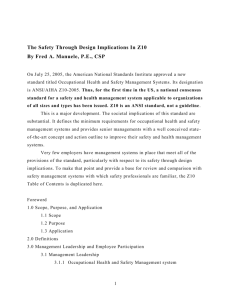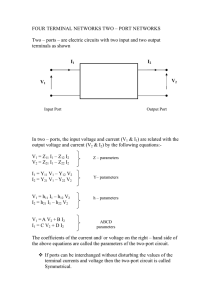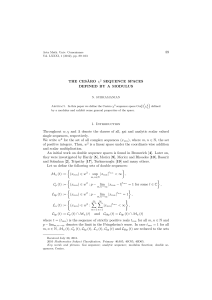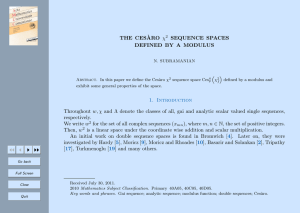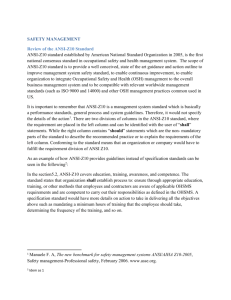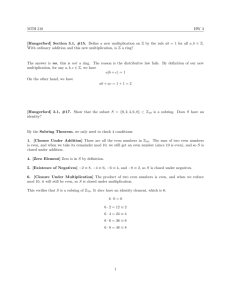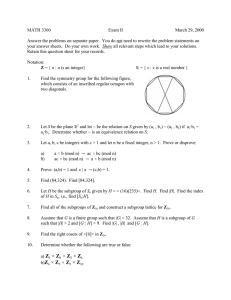Document 10450530
advertisement
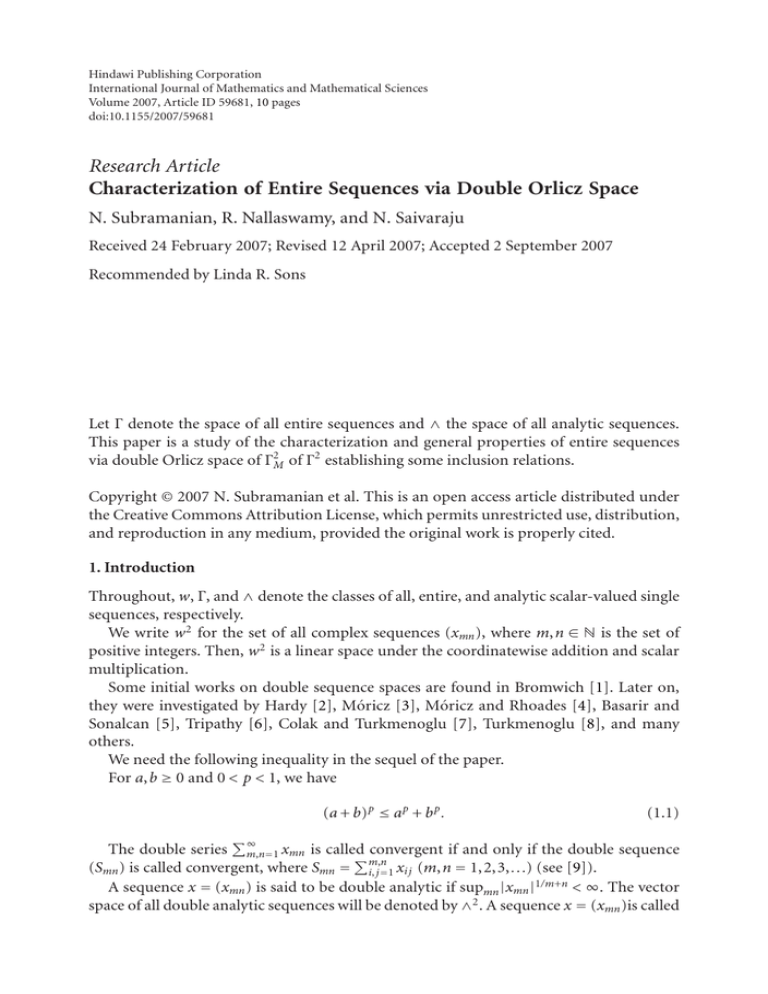
Hindawi Publishing Corporation
International Journal of Mathematics and Mathematical Sciences
Volume 2007, Article ID 59681, 10 pages
doi:10.1155/2007/59681
Research Article
Characterization of Entire Sequences via Double Orlicz Space
N. Subramanian, R. Nallaswamy, and N. Saivaraju
Received 24 February 2007; Revised 12 April 2007; Accepted 2 September 2007
Recommended by Linda R. Sons
Let Γ denote the space of all entire sequences and ∧ the space of all analytic sequences.
This paper is a study of the characterization and general properties of entire sequences
via double Orlicz space of Γ2M of Γ2 establishing some inclusion relations.
Copyright © 2007 N. Subramanian et al. This is an open access article distributed under
the Creative Commons Attribution License, which permits unrestricted use, distribution,
and reproduction in any medium, provided the original work is properly cited.
1. Introduction
Throughout, w, Γ, and ∧ denote the classes of all, entire, and analytic scalar-valued single
sequences, respectively.
We write w2 for the set of all complex sequences (xmn ), where m,n ∈ N is the set of
positive integers. Then, w2 is a linear space under the coordinatewise addition and scalar
multiplication.
Some initial works on double sequence spaces are found in Bromwich [1]. Later on,
they were investigated by Hardy [2], Móricz [3], Móricz and Rhoades [4], Basarir and
Sonalcan [5], Tripathy [6], Colak and Turkmenoglu [7], Turkmenoglu [8], and many
others.
We need the following inequality in the sequel of the paper.
For a,b ≥ 0 and 0 < p < 1, we have
(a + b) p ≤ a p + b p .
(1.1)
The double series ∞
convergent if and only if the double sequence
m,n=1 xmn is called
(Smn ) is called convergent, where Smn = m,n
i, j =1 xi j (m,n = 1,2,3,...) (see [9]).
A sequence x = (xmn ) is said to be double analytic if supmn |xmn |1/m+n < ∞. The vector
space of all double analytic sequences will be denoted by ∧2 . A sequence x = (xmn )is called
2
International Journal of Mathematics and Mathematical Sciences
double entire sequence if |xmn |1/m+n → 0 as m,n → ∞. The double entire sequences will
be denoted by Γ2 . Let Φ = {all finite sequences}.
Consider a double sequence x = (xi j ). The (m,n)th section x[m,n] of the sequence is
defined by x[m,n] = m,n
i, j =0 xi j δi j for all m,n ∈ N,
⎛
⎞
0,0,...,0,0,...
⎜
⎟
⎜0,0,...,0,0,...⎟
⎜
⎟
⎜
⎟
..
⎟,
δmn = ⎜
.
(1.2)
⎜
⎟
⎜
⎟
⎝0,0,...,1,0,...⎠
0,0,...,0,0,...
with 1 in the (m,n)th position and zero otherwise. An FK-space (or a metric space) X is
said to have AK property if (δmn ) is a Schauder basis for X. Or equivalently, x[m,n] → x.
An FDK space is a double sequence space endowed with a complete metrizable; locally
convex topology under which the coordinate mappings x = (xk ) → (xmn ) (m,n ∈ N) are
also continuous.
Orlicz [10] used the idea of Orlicz function to construct the space (LM ). Lindenstrauss
and Tzafriri [11] investigated Orlicz sequence spaces in more detail, and they proved that
every Orlicz sequence space M contains a subspace isomorphic to p (1 ≤ p < ∞). Subsequently, different classes of sequence spaces were defined by Parashar and Choudhary
[12], Mursaleen et al. [13], Bektaş and Altin [14], Tripathy et al. [15], Rao and Subramanian [16], and many others. The Orlicz sequence spaces are the special cases of Orlicz
spaces studied in [17].
Recalling [10] and [17], an Orlicz function is a function M : [0, ∞) → [0, ∞) which is
continuous, nondecreasing, and convex with M(0) = 0, M(x) > 0, for x > 0 and M(x) →
∞ as x → ∞. If convexity of Orlicz function M is replaced by M(x + y) ≤ M(x) + M(y),
then this function is called modulus function, defined by Nakano [18] and further discussed by Ruckle [19], Maddox [20], and many others.
Let (Ω,Σ,μ) be a finite measure space. We denote by E(μ) the space of all (equivalence
classes of) Σ-measurable functions x from Ω into [0, ∞). Given an Orlicz function M, we
define on E(μ)a convex functional IM by
IM (x) =
Ω
M x(t) dμ,
(1.3)
and an Orlicz space LM (μ) by LM (μ) = {x ∈ E(μ) : IM (λx) < +∞ for some λ > 0} (for
detail, see [10, 17]).
Lindenstrauss and Tzafriri [11] used the idea of Orlicz function to construct Orlicz
sequence space:
M = x ∈ w :
∞
k =1
M
x k ρ
< ∞ for some ρ > 0 ,
(1.4)
N. Subramanian et al. 3
where w = {all complex sequences}. The space M with the norm
x = inf ρ > 0 :
∞
M
x k ρ
k =1
≤1
(1.5)
becomes a Banach space which is called an Orlicz sequence space. For M(t) = t p (1 ≤ p <
∞), the spaces M coincide with the classical sequence space p .
If X is a sequence space, we give the following definitions:
dual of X;
(i) X = the continuous
∞
α
(ii) X = {a = (amn ) : m,n=1 |amn xmn | < ∞, for each x ∈ X };
(iii) X β = {a = (amn ) : ∞
m,n=1 amn xmn is convergent, for each x ∈ X };
(iv) X γ = {a = (amn ) : supm,n≥1 | M,N
m,n=1 amn xmn | < ∞, for each x ∈ X };
(v) let X be an FK-space ⊃ Φ, then X f = { f (δmn ) : f ∈ X };
(vi) X ∧ = {a = (amn ) : sup(mn) |amn xmn |1/m+n < ∞, for each x ∈ X };
(vii) X α , X β , X γ are called α-(or Köthe-Toeplitz) dual of X, β-(or generalized KötheToeplitz) dual of X, γ-dual of X, and ∧-dual of X, respectively.
2. Definitions and preliminaries
Throughout the article, w2 denote the spaces of all sequences. Γ2M and ∧2M denote the
Pringscheims of double Orlicz space of entire sequence and Pringscheims of double Orlicz space of bounded sequence, respectively
Let w2 denote the set of all complex double sequences x = (xmn )∞
m,n=1 and M : [0, ∞) →
[0, ∞) be an Orlicz function, or a modulus function. Given a double sequence, x ∈ w2 .
Let t denote the double sequence with tmn = |xmn |1/(m+n) for all m,n ∈ N. Define the sets
Γ2M
tmn
= x∈w : M
ρ
2
∧2M
2
= x ∈ w : sup(m,n)
−→ 0 (m,n −→ ∞) for some ρ > 0 ,
t
M mn
ρ
(2.1)
< ∞ for some ρ > 0 .
The space ∧2M is a metric space with the metric
xmn − ymn 1/m+n
d(x, y) = inf ρ > 0 : sup(m,n) M
≤1
(2.2)
ρ
and the space Γ2M is a metric space with the metric
d(x, y) = ρ > 0 : sup(m,n) M
xmn − ymn 1/m+n
ρ
: m,n = 1,2,3,... .
(2.3)
4
International Journal of Mathematics and Mathematical Sciences
3. Main results
Proposition 3.1. If M is a modulus function, then Γ2M is a linear set over the set of complex
numbers C.
Proof. It is trivial. Therefore, the proof is omitted.
Proposition 3.2. (Γ2M )β ⊂= ∧2 .
Proof. Let y = { ymn } be an arbitrary point in (Γ2M )β . If y is not in ∧2 , then for each natural
number p, we can find an index m p n p such that
M
1/m p +n p ym p n p ρ
> p,
(p = 1,2,3,...).
(3.1)
Define x = {xmn } by
x
M mn
ρ
x
M mn
ρ
=
1
pm+n
=0
for (m,n) = m p ,n p for some p ∈ N,
(3.2)
otherwise.
Then x is in Γ2M , but for infinitely mn,
M
ymn xmn ρ
> 1.
(3.3)
Consider the sequence z = {zmn }, where M(z11 /ρ) = M(x11 /ρ) − s with
s=
x
M mn ,
ρ
z
M mn
ρ
xmn
=M
ρ
(m,n = 1,2,3,...).
(3.4)
Then, z is a point of Γ2M . Also, M(zmn /ρ) = 0. Hence, z is in Γ2M ; but, by (3.3),
M(zmn ymn /ρ) does not converge:
=⇒ Σxmn ymn diverges.
(3.5)
Thus, the sequence y would not be in (Γ2M )β . This contradiction proves that
Γ2M
β
⊂ ∧2 .
(3.6)
N. Subramanian et al. 5
If we now choose M = id, where id is the identity and y1n = x1n = 1 and ymn = xmn = 0
(m > 1) for all n, then obviously x ∈ Γ2M and y ∈ ∧2 , but
∞
m,n=1
β
xmn ymn = ∞. Hence, y ∈
/ Γ2M .
(3.7)
From (3.6) and (3.7), we are granted (Γ2M )β ⊂= ∧2 . This completes the proof.
Γ2M
Proposition 3.3.
has AK, where M is a modulus function.
Proof. Let x = (xmn ) ∈ Γ2M and take x[mn] =
d x,x
[rs]
−→ 0
= ρ : sup(m,n) M
m,n
i, j =1 xi j δi j
for all m,n ∈ N. Hence,
xmn 1/m+n
ρ
: m ≥ r + 1, n ≥ s + 1
as m,n −→ ∞.
Therefore, x[rs] → x as r,s → ∞ in Γ2M . Thus, Γ2M has AK. This completes the proof.
Proposition 3.4.
(3.8)
Γ2M
is solid.
Proof. Let |xmn | ≤ | ymn | and let y = (ymn ) ∈ Γ2M · (M(|xmn |1/m+n /ρ)) ≤ (M(| ymn |1/m+n /ρ)),
because M is nondecreasing. But (M(| ymn |1/m+n /ρ)) ∈ Γ2 because y ∈ Γ2M . That is,
(M(| ymn |1/m+n /ρ)) → 0 as m,n → ∞ and (M(|xmn |1/m+n ρ)) → 0 as m,n → ∞. Therefore,
x = {xmn } ∈ Γ2M . This completes the proof.
Proposition 3.5. (Γ2M )∧ ⊂= ∧2 .
Proof. Let y ∈ ∧-dual of Γ2M . Then, (M(|xmn ymn |/ρ)) ≤ M m+n for some constant M > 0
and for all x ∈ Γ2M . Therefore, (M(| ymn |/ρ)) ≤ M m+n for all m,n by taking x = (δmn ). This
implies that y ∈ ∧2 . Thus,
Γ2M
∧
⊂ ∧2 .
(3.9)
We now choose M = id and define the double sequences (ymn ) and (xmn ) by ymn = 1
2
for all m and n, and by xm1 = 2(m+1) and xmn = 0 (n ≥ 2) for all m = 1,2,.... Obviously,
y ∈ ∧2 and since xmn = 0 for all m,n ≥ 0, (xmn ) converges to zero in the Pringsheim sense.
Hence, x ∈ Γ2M . But,
am1 xm1 1/(m+1) = 2m+1 −→ ∞
as m −→ ∞, hence x ∈
/ Γ2M
∧
.
From (3.9) and (3.10), we are granted (Γ2M )∧ ⊂= ∧2 . This completes the proof.
(3.10)
6
International Journal of Mathematics and Mathematical Sciences
Proposition 3.6. The dual space of (Γ2M ) is ∧2 . In other words, (Γ2M )∗ = ∧2 .
Proof. We recall that
⎛
⎞
0,0,...,0,0,...
⎜
⎟
⎜0,0,...,0,0,...⎟
⎜
⎟
⎜
⎟
..
⎟
δmn = ⎜
.
(3.11)
⎜
⎟
⎜
⎟
⎝0,0,...,1,0,...⎠
0,0,...,0,0,...
has 1 in the (m,n)th position and zero otherwise, with
x = δmn , M
⎛
1/m+n xmn ρ
M (0)1/2 /ρ,M (0)1/3 /ρ,M (0)1/2 /ρ,...
M (0)1/3 /ρ ,M (0)1/4 /ρ ,M (0)1/5 /ρ ,...
..
.
⎞
⎟
⎜
⎟
⎜
⎟
⎜
⎟
⎜
⎟
⎜
⎟
⎜
=⎜
1/m+n /ρ ,M (0)/ρ ,...⎟
,M
(0)/ρ
,...,M
(1)
⎟
⎜M (0)/ρ
⎟
⎜
⎜ M (0)/ρ ,M (0)/ρ ,...,M (0)/ρ ,M (0)/ρ ,... ⎟
⎠
⎝
(3.12)
..
.
which is a double null sequence.
2
2 ∗
2 ∗
Hence, δmn ∈ Γ2M · f (x) = ∞
m,n=1 xmn ymn with x ∈ ΓM and f ∈ (ΓM ) , where (ΓM ) is
2
2
the dual space of ΓM . Take x = (xmn ) = δmn ∈ ΓM . Then,
ymn ≤ f d δmn ,0 < ∞
∀m,n.
(3.13)
Thus, (ymn ) is a double bounded sequence, and hence a double analytic sequence. In
other words, y ∈ ∧2 . Therefore, (Γ2M )∗ = ∧2 . This completes the proof.
Proposition 3.7. (∧2M )β ⊂= Γ2M .
Proof. Let (xmn ) ∈ (∧2M )β ,
=⇒
∞
m,n=1
xmn ymn converges ∀ y ∈ ∧2M .
(3.14)
/ Γ2M . Then, there exist a sequence positive integers (m p + n p )
Let us assume that (xmn ) ∈
strictly increasing such that
M
x(m p +n p ) ρ
>
1
,
2(m p +n p )
(p = 1,2,3,...).
(3.15)
N. Subramanian et al. 7
Let
y(m p ,n p ) = 2(m p +n p )
ym,n = 0,
(for p = 1,2,3,...),
(3.16)
otherwise.
Then, (ymn ) ∈ ∧2M .
However,
∞
M
xmn ymn m,n=1
ρ
=
∞
M
p =1
x(m p n p ) y(m p n p ) ρ
> 1 + 1 + 1 + ··· .
We know that the infinite series 1 + 1 + 1 + · · · diverges. Hence,
diverges. This contradicts (3.14). Hence, (xmn ) ∈ Γ2M . Therefore,
∧2M
β
(3.17)
∞
m,n=1 (M(|xmn ymn |/ρ))
⊂ Γ2M .
(3.18)
If we now choose M = id, where id is the identity and y1n = x1n = 1 and ymn = xmn = 0
(m > 1) for all n, then obviously x ∈ Γ2M and y ∈ ∧2M , but
∞
m,n=1
xmn ymn = ∞. Hence, y ∈
/ ∧2M
β
.
(3.19)
From (3.18) and (3.19), we are granted (∧2M )β ⊂= Γ2M . This completes the proof.
Definition 3.8. Let p = (pmn ) be a double sequence of positive real numbers. Then,
Γ2M (p) =
x = xmn : M
|xmn |1/m+n
pmn
ρ
−→ 0 (m,n −→ ∞) for some ρ > 0 .
(3.20)
Suppose that pmn is a constant for all m,n, then Γ2M (p) = Γ2M .
Proposition 3.9. Let 0 ≤ pmn ≤ qmn and let {qmn / pmn } be bounded. Then, Γ2M (q) ⊂ Γ2M (p).
Proof. Let
x ∈ Γ2M (q),
(3.21)
then
M
qmn
xmn 1/m+n
ρ
−→ 0
as m,n −→ ∞.
(3.22)
8
International Journal of Mathematics and Mathematical Sciences
Let tmn = (M(|xmn |1/m+n /ρ))qmn , and let λmn = pmn /qmn . Since pmn ≤ qmn , we have 0 ≤
λmn ≤ 1. Let 0 < λ < λmn , then
⎧
⎨tmn
umn = ⎩
0
⎧
⎨0
vmn = ⎩
tmn
tmn = umn + vmn ,
tmn ≥ 1 ,
tmn < 1 ,
tmn ≥ 1 ,
tmn < 1 ,
(3.23)
λmn
λmn
mn
tmn
= uλmn
+ vmn
.
Now, it follows that
mn
≤ umn ≤ tmn ,
uλmn
λmn
λ
vmn
≤ vmn
.
(3.24)
λmn
λmn
λmn
λmn
λ . Thus, (M(|x |1/m+n /ρ)qmn )λmn ≤
Since tmn
= umn
+ vmn
, we have tmn
≤ tmn + vmn
mn
1/m+n
q
mn
(M(|xmn |
/ρ)) and
M
xmn 1/m+n qmn pmn /qmn
ρ
≤ M
qmn
xmn 1/m+n
ρ
,
(3.25)
which yields (M(|xmn |1/m+n /ρ)) pmn ≤ (M(|xmn |1/m+n /ρ))qmn . However, (M(|xmn |1/m+n /
ρ))qmn → 0 (by (3.22)). Thus, (M(|xmn |1/m+n /ρ)) pmn → 0 as m,n → ∞.
Hence,
x ∈ Γ2M (p).
(3.26)
From (3.21) and (3.26), we are granted
Γ2M (q) ⊂ Γ2M (p).
(3.27)
This completes the proof.
Proposition 3.10. (a) If 0 < inf pmn ≤ pmn ≤ 1, then Γ2M (p) ⊂ Γ2M .
(b) If 1 ≤ pmn ≤ sup pmn < ∞, then Γ2M ⊂ Γ2M (p).
Proof. The above statements are special cases of Proposition 3.9. Therefore, it can be
proved by similar arguments.
Proposition 3.11. If 0 < pmn ≤ qmn < ∞ for each m,n, then Γ2M (p) ⊆ Γ2M (q).
Proof. Let x ∈ Γ2M (p), then
M
pmn
xmn 1/m+n
ρ
−→ 0
as m,n −→ ∞.
(3.28)
N. Subramanian et al. 9
This implies that (M(|xmn |1/m+n /ρ)) ≤ 1 for sufficiently large m,n. Since M is nondecreasing, we get
M
qmn
xmn 1/m+n
ρ
≤ M
pmn
xmn 1/m+n
ρ
,
(3.29)
1/m+n
then (M(xmn /ρ))qmn → 0 as m,n → ∞ (by using (3.28)). Let x ∈ Γ2M (q). Hence,
2
2
ΓM (p) ⊆ ΓM (q). This completes the proof.
Acknowledgment
The authors wish to thank Professor Linda R. Sons (Department of Mathematical Sciences, Northen Illinois University, DeKalb, USA) for the valuable comments and
suggestions.
References
[1] T. J. I. Bromwich, An Introduction to the Theory of Infinite Series, Macmillan, New York, NY, USA,
1965.
[2] G. H. Hardy, “On the convergence of certain multiple series,” Proceedings of the Cambridge Philosophical Society, vol. 19, pp. 86–95, 1917.
[3] F. Móricz, “Extensions of the spaces c and c0 from single to double sequences,” Acta Mathematica
Hungarica, vol. 57, no. 1-2, pp. 129–136, 1991.
[4] F. Móricz and B. E. Rhoades, “Almost convergence of double sequences and strong regularity of summability matrices,” Mathematical Proceedings of the Cambridge Philosophical Society,
vol. 104, no. 2, pp. 283–294, 1988.
[5] M. Basarir and O. Sonalcan, “On some double sequence spaces,” Journal of the Indian Academy
of Mathematics, vol. 21, no. 2, pp. 193–200, 1999.
[6] B. C. Tripathy, “Statistically convergent double sequences,” Tamkang Journal of Mathematics,
vol. 34, no. 3, pp. 231–237, 2003.
[7] R. Colak and A. Turkmenoglu, “The double sequence spaces ∞ 2 (p), c0 2 (p) and c2 (p),” in preparation.
[8] A. Turkmenoglu, “Matrix transformation between some classes of double sequences,” Journal of
Institute of Mathematics & Computer Sciences, vol. 12, no. 1, pp. 23–31, 1999.
[9] T. Apostol, Mathematical Analysis, Addison-Wesley, London, UK, 1978.
[10] W. Orlicz, “Über Raume (LM ),” Bulletin International de l’Académie Polonaise des Sciences et des
Lettres, Série A, pp. 93–107, 1936.
[11] J. Lindenstrauss and L. Tzafriri, “On Orlicz sequence spaces,” Israel Journal of Mathematics,
vol. 10, pp. 379–390, 1971.
[12] S. D. Parashar and B. Choudhary, “Sequence spaces defined by Orlicz functions,” Indian Journal
of Pure and Applied Mathematics, vol. 25, no. 4, pp. 419–428, 1994.
[13] Mursaleen, M. A. Khan, and Qamaruddin, “Difference sequence spaces defined by Orlicz functions,” Demonstratio Mathematica, vol. 32, no. 1, pp. 145–150, 1999.
[14] Ç. A. Bektaş and Y. Altin, “The sequence space lM (p, q,s) on seminormed spaces,” Indian Journal
of Pure and Applied Mathematics, vol. 34, no. 4, pp. 529–534, 2003.
[15] B. C. Tripathy, M. Et, and Y. Altin, “Generalized difference sequence spaces defined by Orlicz
function in a locally convex space,” Journal of Analysis and Applications, vol. 1, no. 3, pp. 175–
192, 2003.
10
International Journal of Mathematics and Mathematical Sciences
[16] K. Chandrasekhara Rao and N. Subramanian, “The Orlicz space of entire sequences,” International Journal of Mathematics and Mathematical Sciences, vol. 2004, no. 68, pp. 3755–3764,
2004.
[17] M. A. Krasnoselskii and Y. B. Rutickii, Convex Functions and Orlicz Spaces, Noordhoff, Gorningen, The Netherlands, 1961.
[18] H. Nakano, “Concave modulars,” Journal of the Mathematical Society of Japan, vol. 5, no. 1, pp.
29–49, 1953.
[19] W. H. Ruckle, “FK spaces in which the sequence of coordinate vectors is bounded,” Canadian
Journal of Mathematics, vol. 25, pp. 973–978, 1973.
[20] I. J. Maddox, “Sequence spaces defined by a modulus,” Mathematical Proceedings of the Cambridge Philosophical Society, vol. 100, no. 1, pp. 161–166, 1986.
N. Subramanian: Department of Mathematics, SASTRA University, Tanjore 613 402, India
Email address: nsmaths@yahoo.com
R. Nallaswamy: Department of Mathematics, National Institute of Technology,
Tiruchirappalli 620 015, India
Email address: nalla@nit.edu
N. Saivaraju: Department of Mathematics, Shri Angalamman College of Engineering and
Technology, Anna University, Tiruchirappalli 621 105, India
Email address: saivaraju@yahoo.com

